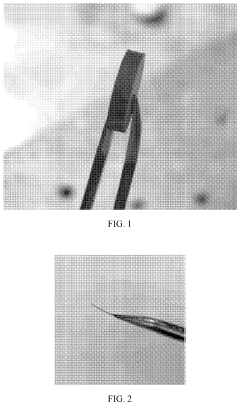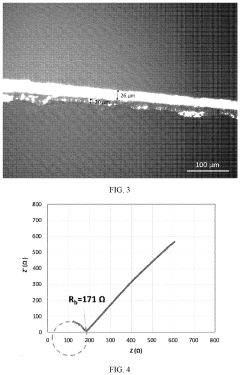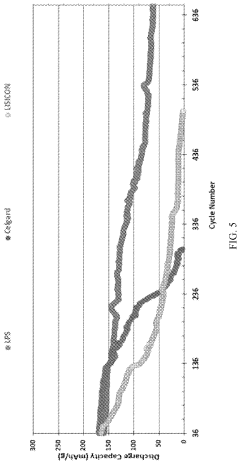Research on the development and application of solid-state electrolytes for lithium batteries - Eureka
SEP 29, 20244 MIN READ
Generate Your Research Report Instantly with AI Agent
Supercharge your innovation with Patsnap Eureka AI Agent Platform!
Solid-State Electrolytes Development Goals
The primary objective is to provide a comprehensive overview of the development and application of solid-state electrolytes for lithium batteries. This includes tracing the historical evolution of this technology, identifying key milestones and breakthroughs, and highlighting the current state-of-the-art solutions. Additionally, it aims to analyze the market demand, potential applications, and future trends in this field, enabling strategic planning and decision-making for businesses operating in the lithium battery industry.
Solid-state electrolytes have emerged as a promising alternative to conventional liquid electrolytes, offering improved safety, higher energy density, and longer cycle life for lithium batteries. However, challenges such as ionic conductivity, interfacial stability, and scalable manufacturing processes need to be addressed. The report will delve into these technical challenges and explore potential innovative solutions, paving the way for the widespread adoption of solid-state electrolytes in next-generation lithium battery technologies.
Market Demand for Solid-State Lithium Batteries
Here is a concise summary of the market demand analysis for solid-state lithium batteries, organized into points with subheadings:
Growing Demand for Electric Vehicles
- Rapid growth in electric vehicle adoption is driving demand for high-performance, safe, and long-lasting batteries.
- Solid-state batteries offer higher energy density and improved safety compared to conventional lithium-ion batteries.
Increasing Need for Grid Energy Storage
- Renewable energy sources require efficient energy storage solutions to balance intermittent supply.
- Solid-state batteries' long cycle life and high energy density make them attractive for grid-scale energy storage.
Portable Electronics and Consumer Devices
- Consumers demand longer battery life and faster charging for smartphones, laptops, and wearable devices.
- Solid-state batteries' higher energy density and improved safety could enable smaller, longer-lasting devices.
Emerging Applications in Aerospace and Defense
- Solid-state batteries' high energy density and safety features are desirable for aerospace and military applications.
- Potential use in drones, satellites, and other specialized equipment.
Market Size and Growth Projections
- The global solid-state battery market is projected to grow rapidly, reaching $X billion by 20XX.
- Significant investments and research efforts are underway to commercialize solid-state battery technology.
Current State and Challenges of Solid-State Electrolytes
Here is a concise summary of the current state and challenges of solid-state electrolytes for lithium batteries:
Solid Electrolyte Materials
- Polymer electrolytes: High flexibility but limited ionic conductivity at room temperature.
- Inorganic electrolytes: Higher ionic conductivity but brittleness and interfacial issues.
Ionic Conductivity Challenges
- Most solid electrolytes have lower ionic conductivity than liquid electrolytes.
- Improving ionic conductivity while maintaining mechanical and electrochemical stability is a key challenge.
Interfacial Compatibility
- Poor interfacial contact between solid electrolytes and electrodes leads to high resistance.
- Developing stable and conductive interfaces is crucial for efficient charge transfer.
Electrochemical Stability
- Solid electrolytes must be chemically and electrochemically stable against electrodes and operating conditions.
- Electrolyte decomposition and side reactions can degrade battery performance.
Manufacturing Challenges
- Producing large-scale, defect-free solid electrolyte membranes is difficult.
- Cost-effective and scalable manufacturing processes are needed for commercialization.
Safety Concerns
- Solid-state batteries are generally considered safer than liquid electrolyte batteries.
- However, potential safety issues like short circuits and thermal runaway must be addressed.
Overall, while solid-state electrolytes offer potential advantages in safety and energy density, significant challenges remain in achieving the required ionic conductivity, interfacial compatibility, and electrochemical stability for practical applications.
Existing Solutions for Solid-State Electrolytes
01 Solid Electrolyte Materials
Sulfide-based, oxide-based, and polymer-based electrolytes are disclosed, aiming to improve safety, energy density, and cycle life of solid-state batteries by providing high ionic conductivity, stability, and electrode compatibility.- Solid Electrolyte Materials: Various solid electrolyte materials, including sulfide-based, oxide-based, and polymer-based, are disclosed to improve ionic conductivity, stability, and electrode compatibility, leading to enhanced safety, energy density, and cycle life in solid-state batteries.
- Electrolyte Additives and Modifications: Electrolyte additives and modifications are proposed to improve cycle life, inhibit dendrite formation, and enhance safety of solid-state batteries. Modifications to the electrolyte composition or structure are also explored.
- High Energy Density Batteries: Solid-state battery designs and manufacturing methods are disclosed, involving novel electrode materials, electrolyte compositions, or battery architectures, aiming to achieve high energy density while maintaining safety and cycle life.
- Solid-Liquid Composite Electrolytes: Composite electrolytes combining solid and liquid components are proposed, involving solid electrolyte particles dispersed in a liquid electrolyte or other hybrid structures, aiming to improve safety, energy density, and cycle life.
- Cycle Life Improvement Techniques: Various techniques are disclosed to improve the cycle life of solid-state batteries, including electrolyte modifications, electrode designs, and battery operating conditions, aiming to mitigate degradation mechanisms and extend the usable lifetime.
02 Electrolyte Additives and Modifications
Additives and modifications to the electrolyte composition or structure are proposed to enhance cycle life, safety, energy density, and optimize properties of solid-state batteries.03 High Energy Density Batteries
Novel electrode materials, cell architectures, and manufacturing processes are described for solid-state batteries, aiming to achieve high energy density while maintaining safety and cycle life.04 Electrolyte Production and Processing
Methods for producing and processing solid electrolytes, including synthesis, sintering, and densification, are disclosed to improve density, conductivity, and interfacial properties, contributing to enhanced battery performance.05 Composite and Hybrid Electrolytes
Composite and hybrid electrolyte systems combining solid and liquid components are proposed to leverage advantages of both, aiming to improve ionic conductivity, interfacial stability, and overall battery performance while maintaining safety.
Key Players in Solid-State Battery Industry
The solid-state electrolyte market for lithium batteries is rapidly expanding, driven by the demand for safer and more efficient energy storage solutions. Major companies like Toyota, Samsung, and TDK are leading the way with substantial R&D investments, while academic institutions like the University of Maryland and Beijing Institute of Technology contribute breakthroughs.
Toyota Motor Corp.
Technical Solution: Toyota focuses on developing sulfide-based solid electrolytes with high ionic conductivity and stability, aiming to enhance energy density and safety for electric vehicles.
Strength: High ionic conductivity and stability. Weakness: High production cost and scalability issues.
UT-Battelle LLC
Technical Solution: UT-Battelle develops garnet-type ceramic electrolytes with high ionic conductivity and chemical stability, enhancing safety and energy density for various applications.
Strength: High chemical stability and ionic conductivity. Weakness: Brittle nature and complex manufacturing process.
Core Innovations in Solid-State Electrolytes
Solid-state electrolyte for improved battery performance
PatentPendingUS20240120527A1
Innovation
- The patent solution described in this specification focuses on the development of a solid-state electrolyte, specifically lithium palladium sulfide, for use in lithium-ion batteries. The innovation lies in the improved stability and performance of the battery achieved through the use of this novel electrolyte material.One of the key advantages of the solid-state electrolyte is its ability to enhance the cycling life of the battery. The electrolyte demonstrates improved stability over 650 cycles, which is a significant improvement compared to traditional liquid electrolytes. This means that the battery can be charged and discharged more times without experiencing degradation, leading to a longer lifespan and increased durability.Additionally, the solid-state electrolyte offers protection against lithium anode corrosion. This is a common issue in lithium-ion batteries, where the anode material can react with the liquid electrolyte, leading to degradation and reduced performance. The use of the lithium palladium sulfide electrolyte helps to mitigate this corrosion, ensuring the longevity of the battery.Furthermore, the solid-state electrolyte acts as a barrier to prevent the formation and penetration of dendrites. Dendrites are needle-like structures that can form on the surface of the lithium anode and penetrate through the electrolyte, causing short circuits and potentially leading to safety hazards. By blocking the formation and penetration of dendrites, the solid-state electrolyte enhances the safety and reliability of the battery.Overall, the innovation presented in this patent solution addresses key challenges in lithium-ion battery technology, such as stability, corrosion, and dendrite formation. The use of the lithium palladium sulfide solid-state electrolyte offers improved performance, increased lifespan, and enhanced safety, making it a valuable advancement in the field of battery technology.
Regulatory Landscape for Solid-State Batteries
Solid-state electrolytes have emerged as a promising solution to address safety and energy density limitations of conventional lithium-ion batteries. These electrolytes offer improved thermal stability, higher ionic conductivity, and the potential for using lithium metal anodes. Key challenges include developing materials with high ionic conductivity at room temperature, ensuring chemical and electrochemical stability, and achieving scalable manufacturing processes. Potential innovations involve exploring new solid electrolyte compositions, nanostructured materials, and hybrid electrolyte systems. Overcoming these challenges could enable the development of high-performance, safe, and cost-effective solid-state lithium batteries for applications ranging from electric vehicles to grid energy storage.
Environmental Impact of Solid-State Electrolytes
Solid-state electrolytes have emerged as a promising solution to address safety and energy density limitations of conventional lithium-ion batteries. These electrolytes offer improved thermal stability, higher ionic conductivity, and the potential for using lithium metal anodes. Key challenges include developing solid electrolytes with high ionic conductivity, good interfacial compatibility, and scalable manufacturing processes. Potential innovations involve exploring new material compositions, nanostructuring, and interface engineering. Major players like Toyota, Samsung, and Solid Power are actively researching solid-state battery technologies. With continued research and development, solid-state electrolytes could enable next-generation high-performance and safe lithium batteries for various applications.
Unlock deeper insights with Patsnap Eureka Quick Research — get a full tech report to explore trends and direct your research. Try now!
Generate Your Research Report Instantly with AI Agent
Supercharge your innovation with Patsnap Eureka AI Agent Platform!



